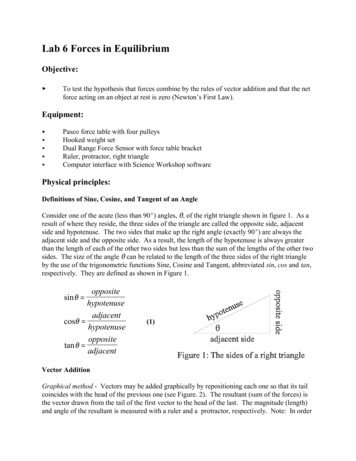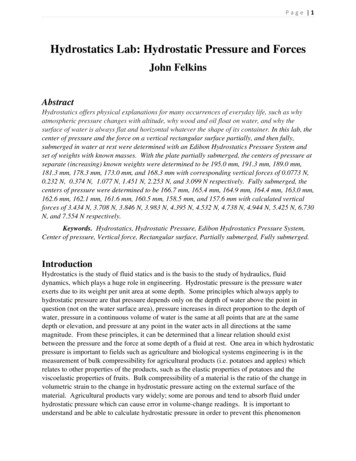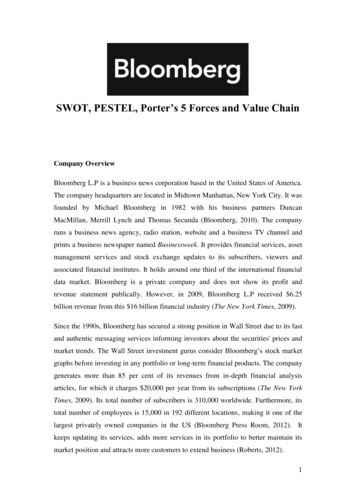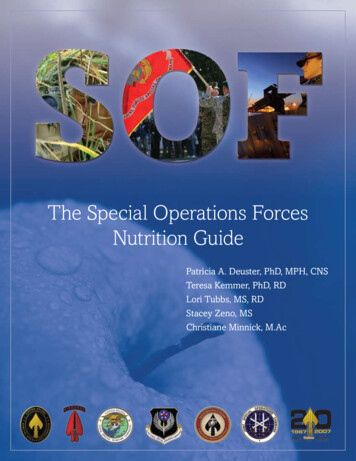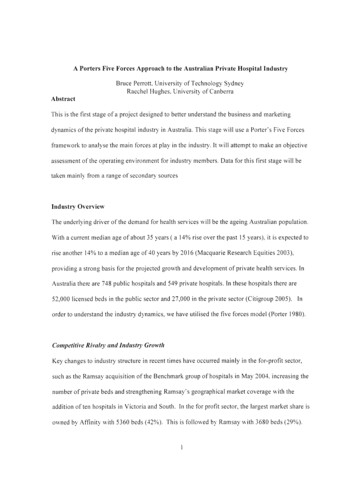
Transcription
A Porters Five Forces Approachto the AustralianPrivate Hospital IndustryBruce Perrott University of Technology SydneyRaechel Hughes, University of CanberraAbstractThis is the first stage of a project designed to better understanddynamicsof the private hospitalindustry in Australia.the businessand marketingThis stage will use a Porter'sFive Forcesframeworkto analyse the main forces at play in the industry. It will attempt to make an objectiveassessmentof the operatingenvironmenttaken mainly from a range of secondaryfor industry members.Data for this first stage will besourcesInd ustry OverviewThe underlyingdriver of the demand for health services will be the ageing Australianpopulation.With a current median age of about 35 years ( a 14% rise over the past 15 years), it is expectedrise another14% to a median age of 40 years by 2016 (Macquarieprovidinga strong basis for the projectedAustraliathere are 748 public hospitalsResearchgrowth and developmentand 549 private hospitals.Equitiesthe industry dynamics,2003),of private health services.In these hospitals52,000 licensed beds in the public sector and 27,000 in the private sector (Citigrouporder to understandtoInthere are2005).we have utilised the five forces model (PorterIn1980).Competitive Rivalry and Industry GrowthKey changes to industry structuresuch as the Ramsay acquisitionin recent times have occurredof the Benchmarknumber of private beds and strengtheningaddition oftenhospitalsowned by Affinityin Victoriagroup of hospitalsRamsay'sand South.mainly in the for-profitgeographicalsector,in May 2004, increasingmarket coveragethewith theIn the for profit sector, the largest market share iswith 5360 beds (42%). This is followedby Ramsaywith 3680 beds (29%).
Healthscopeholds a 20% share, with 2585 beds. Nova Health, with 768 beds, holds a 6% share,and finally with just 2% share is Macquariewould have looked differentHealth, with 256 beds. The competitiveto this if Ramsay had been successfulin 2003 from the Mayne Group. If this had occurred,acquisitionwould have happenedas it did in 2004. Under this scenario,with 8% market share.5367 beds; Ramsay 3967 and Healthscopeas intense as expectedstrategicallythe Affinity bedsthen it is unlikely that the Benchmarkbed market share near 70% (say 8105 beds), Healthscopeleaving Benchmarkin acquiringRamsay could have had awith about 22% share (2585 beds),More recently, it has been estimated2400 (Greenblatdue to the geographicallandscapepositioning2004).that Affinity hasCompetitiveintensity is notof each hospital, which is locatednear the markets that yield both patients and medical referrals.Geographicalpositioningalso substantiallyproduct, service and brand strategies.number of elementsreduces the need to aggressivelyTo the degree that these companiesthat need to be considered,doctors ( General Practionersand Specialists);differentiatecompete,including the type and reputationthe geographicalthe product/ case mix offered and the availabilitywiththere are aof referringlocation of the hospital facility;of quality staff (Patrick Grier, a) 2004).Industry growth is also a factor that can impact on the degree of competitiverivalry existing in anindustry at a point in time - if growth is slow, it would be expected that rivalry would beincreased (Johnson,level of attractivenessmeasure of operatingwas marginallyoccupancycomparedScholes and Whittingtonto potentialefficiency.2005).Growth will also have an impact on thenew entrants to the industry, with bed occupancyIn 2002-03,this segment had an occupancyhigher than the previous year with 75.2%. It is also significantrate was higher in hospitalslocated in the Capital City Statisticalwith 70.9% in Rest of State and Territory2Divisions(ABS, 2004).a goodrate of 75.6% whichto note that theDivisionsat 77.3%,This creates a strong
competitiveadvantagefor companiesestablishednetworks of referring doctors.2002-03, the net operatingwith hospitals with establishedFor acute and psychiatricoperationsprivatewhich havehospitalsduringmargin was reported to be 6%, steady at the leve I of the previous yearbut above the average margin for the five years to 2002-03 of 5% (ABS, 2004).Non Profit Private Hospitals: Private hospitals operatedoffer an alternativesource of private hospital services to some Australian2002-03. religious or charitableand psychiatricprivate hospitals.acute and psychiatrichospital groups accountedTheir occupancybed occupancy75.6% for 2002-03(ABSwith 2586 beds.by religious or charitable2004).Little Companypatients.for 37% of the availablerate of77.5%for 2002-03institutionsFor the yearbeds in acutewas higher than forin the private hospital group overall which was reported atIn this sector, the Sisters of Charity hold a 30% market share,of Mary follows with 1416 beds (17.2 % share), St John of Godhas 1300 beds (a 15.8 % share); Mercy Health has a 13% share, with 1100 beds.Uniting HealthCare, with 993 beds, holds a 12% share, and finally with a 10% share is Mater Health Services(830 beds) (Department of Health and Ageing. ASS,!\'fRE August 2DD]).Potential Industry EntrantsThe two importantconsiderationsin reviewingthe topic of new entrants to the AustralianHospital Industry are the levels of attractivenessthe focus of operationsand the barriers to entry. Industryfor this analysis (acute and psychiatric)9% per anum over the five years to 2002-03.Removinghas increasedthe adjustmentperiod, the figure shows a 6% growth. Taking income as a key indicatorit can be concludedNet operatingincome formin money terms byfor price changes over theof industry growth, thenthat the industry would be only moderately attractive to potentialmargin can be reviewedPrivateentrants.in our effort to assess the level of industry attractiveness3in
terms of future profitabilityof potential entrants. This has been discussedabove and shows anaverage of 5% for the five years to 2002-03. In terms of profit attractiveness,that the level of industry attractivenessThere are a number of complicationsestablishingnew greenfieldis10\1'in can be concludedto moderate.that potential entrants would face in executinga strategy of( ie building hospitals from scratch) private hospital operationsAustralia.The first is the substantial 450,000per private hospital bed in 2004, making is difficult to achieve an acceptablecapital cost involved, estimated to be in the order ofprofit margin under current operatinglead times necessarycapacity strategicallyland, gain the various approvals,markets. The third and probably theand securing the optimum mix of referring medicalthat is already suffering from a critical shortage. The run on effectof this would be for the tendencyprivate hospital industry operatingA general conclusionto push up ongoing costs for this importantfrom the potentialto enter the Australianingredientto thedimension.new entrant dimensionis that it would be relativelyprivate hospital industry by way of setting up new facilities.Hence the most likely entry strategy would be through the acquisitionwhich was most closely aligned to meeting the strategic objectivesorganisation.and build hospitalThe fourth most critical factor would be the recruiting of nursing and hospital generalstaff in a market environmentunattractivelevel of(Patrick Grier, b), 2004). The second is the longadjacent to prime Australianmost difficult would be in recruitingpractioners.conditionsto find sites, purchasepositionedinThis could be a large offshore companyof an existing operationand fit of the acquiringlooking to diversifygeographicallyin terms of product and case mix. As the assets of each company are specialisedonly able to be applied to the business of private hospital operations,4and/orand thereforeassets could not be readily
applied to another business or industry on a similar scale. Hence the likelihoodwould be by way of selling the whole business or individualcompetitorsIndustryof industry exithospitals combinationsto existingor new industry entrants.AttractivenessOverviewThis section will briefly summariseforces and make a summaryunattractiveness;9tothe circumstancesassessmentof each of the five industry elementsin terms of each areas relative attractiveness:industry members.ororQIndustry CoreThrough progressivetheoreticallyrationalisationand consolidation,the for-profitoperates as an oligopoly with three main companiesprivate hospital beds. In the not-for-profitsector of the industryowning 92% of the market insector there are only four main groups operatingindustry. Under such a market structure one would expect to see intense rivalry manifestof aggressivemarketingactivity in order to maintain or build market shares.Howeverin thein termsin thecase of the private hospital industry, each company and hospital has its unique positioningkey markets and referring doctor networks,companiesin the industry.limiting the competitiveThe negative effect of limited competitivewould be more difficult for an individualrivalry between therivalry also means that itcompany to build market share through aggressivemarketingsimilar to what could happen in most other industries when markets are not asprotected.This limit on the level of competitiveshareholdersrivalry also has longer term benefits toof the three key companies.5near
Another favourablepopulationdimensionis the outlook for industry growth. Due to the ageing Australianoutlined in this paper and the increasingawarenessof the need for high quality healthcare, the demand for health services is likely to continue to grow in the foreseeablethe return to shareholdersof companiesprovided costs are containedfuture. Hencein the private, for profit industry should be maintainedand market shares are not lost to competingindustriessuch as thenot for profit or day care. The search for growth may involve varying degrees of diversification,whether it be into closely associatedhealth services not currently being offered by the privatehospital sector or moving into the closely associatedthose more adventurous,diversifyingcurrently(Pilzer 2002). The beginning'Wellnessbeing forecastIndustry"is anticipated.proactive and dedicatedIn summary,generallyforinto the emerging wellness industry, the birth of which isof a huge industry describedas theHealth care is reactive, while the well ness industry will beto preventingpeople becomingit can be stated that the competitivefavourable;industry of aged care. Alternatively,customersenvironmentof the healthcareindustries.for private hospital membersisQEntrantsThere are moderatelyhigh barriers to entry in this industry. High capital costs and the difficultyin finding and building new hospitalshurdle for potentialnew entrants to the industry. It has been suggestedcosts of building and commissioninga relativelyin locations close to viable markets presents a formidablea hospital bed is about 450,000 (Grier, b) 2004).large scale could take place through acquisition.with substantialfunds to invest into diversifiedlarge US health care company,that the current capitalgeographicalEntry onSuch an entrant could be a companymarkets. An example here may be aor a health insurance company wanting to integrate forward frominsurance to health service provision.Industry entry under these circumstances6cannot be
classifiedas a negative threat to shareholdersneed to pay a premiumto encourageshareholdersinterest in a private health care company.new entrants impactingas it could be assumed that such an entrant wouldof the target organisationFollowingthis rationaleto sell controllingit can be said that the threat ofon industry players in a negative or damagingway to shareholderassets,gand returns is low;SubstitutesSubstitutes,or alternativehealth services,include:- Not for Profit hospitals:Medium to High threat depending on hospital location- Public Hospitals:Low to Medium threat depending upon type of service- Day Care hospitals: Medium threat depending upon type of service and location- Technology as a Substitute to private hospital care (eg e-health):Low threat- Reduction in need/demand for private health services:Nil threatFollowingthis rationaleit can be summarisedon industry players in a negative or damagingis low. Hence this elementis favourablethat the combinedthreat of substitutesway to shareholderimpactinginterests or assets, and returnsgto industry members;SuppliersThis variable has the potentialindustry in managingto be most critical for members of the for profit private hospitalviable hospital units. Individualorganisationsrely on key groups to supplyquality and timely services and products to the various hospital locations.supplier componentsare summarisedEach of the mainas follows;Medical practitioners: Having a strong network of referring doctors is a fundamentalprerequisiteto viability and success. Case histories show that non support of doctor groups can lead to seriousunderperformanceof both individualhospitals and company7groups in this industry (Grier,a)
2004).In Australia,NursingStaff are well organisedin terms of union representationand enjoya strong positive image with the press and the public. Nurses therefore have strong collectivebargainingpower with private hospital groups. Hence they are in a strong position to negotiateconditionsand pay structures.Consumable Medical supplies:industries that are oligopoliesMost consumablesin structure.used in private hospitals are supplied byHence individualexercise some control over price and supply conditions.supplyingcompaniescan usuallyProtheses are a costly componentsome medical treatmentsand are supplied by a limited number of suitable manufacturers.been said that supplyingmanufacturersthat require the use of a prothesisMedical Equipment:dependenton advancingare specified by medical practitionersIt hasin 20 -40% of cases(Grier, b) 2004).Over time the private health industry has become increasinglytechnologydiagnosticsand treatmentopportunityfor competitiveby way of high capital cost equipmentof medical conditions,with limited supp
order to understand the industry dynamics, we have utilised the five forces model (Porter 1980). Competitive Rivalry and Industry Growth Key changes to industry structure in recent times have occurred mainly in the for-profit sector, such as the Ramsay acquisition of the Benchmark group of hospitals in May 2004, increasing the number of private beds and strengthening Ramsay's


